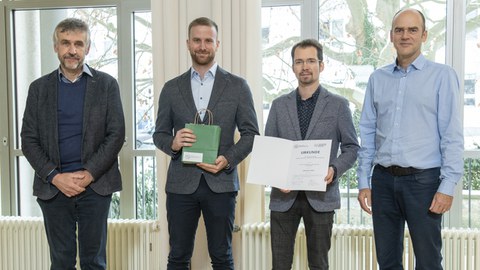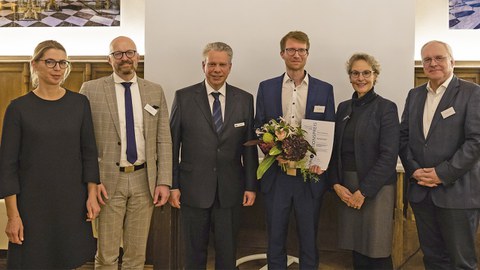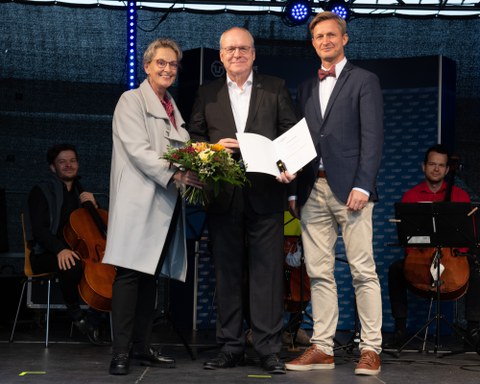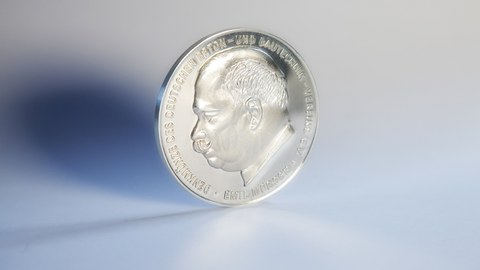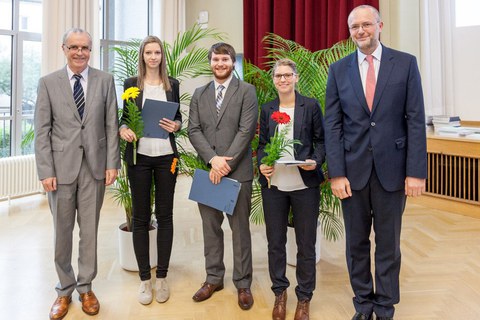Auszeichnungen
Kurt-Beyer-Preis 2024

Adrian Diaconu (HOCHTIEF Infrastructure GmbH, Deutschland Südost) und der Prorektor Forschung Prof. Dr. Lars Bernard übereichen den Preis an Josiane Herfort
Dr.-Ing. Josiane Herfort (Fakultät Bauingenieurwesen) erhält für ihre Dissertation: "Stabilitätssensibilität dünnwandiger Strukturen aus Carbonbeton" den Kurt-Beyer-Preis 2024.
Newsbericht: Kurt-Beyer-Preis 2024
Rüsch-Forschungspreis 2025

Preisverleihung Rüsch-Forschungspreis 2025
Den renommierten Rüsch-Forschungspreis des Deutschen Beton- und Bautechnik-Vereins E.V. (DBV) erhalten 2025 drei junge Forschende, die mit ihren herausragenden wissenschaftlichen Leistungen auf dem Gebiet des Betonbaus die Jury überzeugt haben. Die Preisverleihung fand am 20. März 2025 im Rahmen der Eröffnungsveranstaltung des Deutschen Bautechnik-Tages in Stuttgart statt. Die Jury hob besonders die durchgehend außerordentlich hohe wissenschaftliche Qualität und das hohe Innovationspotenzial aller eingereichten Arbeiten hervor und würdigte dies erstmals mit drei Ehrungen.
Der 2. Platz des Rüsch-Forschungspreises 2025 mit einem Preisgeld von je 2.500 € ging an zwei junge Forschende. Dr.-Ing. Lena Leicht belegte den 2. Platz mit ihrer Dissertation „Characterization of Mineral-Bonded Composites As Damping Layers Against Impact Loading“, die sie an der Fakultät Bauingenieurwesen der Technischen Universität Dresden eingereicht hat. Dr.-Ing. Homam Spartali, RWTH Aachen, belegte ebenfalls den 2. Platz.
Unter betonverein.de/ruesch-forschungspreis finden Sie weitere Informationen zum Rüsch-Forschungspreis.
Kurt-Beyer-Preis 2023
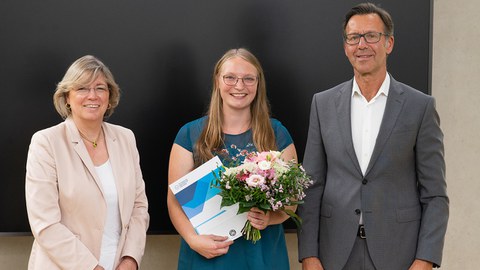
Die Prorektorin Forschung Prof. Dr. Angela Rösen-Wolff und Adrian Diaconu (HOCHTIEF Infrastructure GmbH, Deutschland Südost) übereichen den Preis an Lena Leicht
Dr.-Ing. Lena Leicht (Fakultät Bauingenieurwesen) erhält für ihre Dissertation: "Charakterisierung von mineralisch gebundenen Kompositen zur Impaktdämpfung" den Kurt-Beyer-Preis 2023.
Newsbericht: Kurt-Beyer-Preis 2023
Bautag 2024 – Auszeichnungen der Ostdeutschen Bauindustrie für Absolventen vom Institut für Massivbau

Die Preisträger mit Ihren Betreuern (v.l.n.r.) Prof. Steffen Marx, Dr.-Ing. Oliver Mosig, Fabian Schülke, Sebastian Thiele und Max Herbers M.Sc.
Am 24.05.2024 lud der Bauindustrieverband Ost e. V. zu seinem traditionellen Bautag nach Dresden ein. Gleich zwei der vier Preise gingen an Studenten, deren Arbeiten am Institut für Massivbau entstanden sind.
Newsbericht: Preis des Bauindustrieverband Ost e. V.
Forschung im Projekt Netzgitterträger mit dem Techtextil-Award 2024 ausgezeichnet
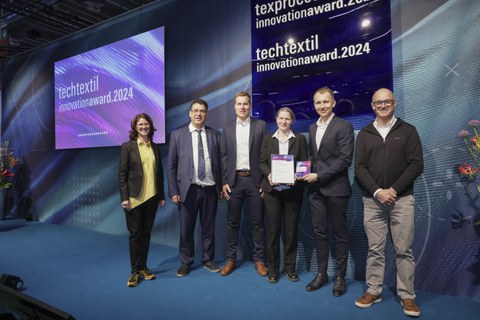
ITM und IMB als Preisträger des Techtextil-Award 2024, v.l.n.r: Sabine Scharrer (Techtextil), Chokri Cherif (ITM), Lars Hahn (ITM), Birgit Beckmann (IMB), Paul Penzel (ITM), António Braz Costa (Jury)
Das ITM und das IMB sind für ihre gemeiname Forschung im Projekt Netzgitterträger am 23.04.2024 in Frankfurt/Main mit dem Techtextil-Award 2024 ausgezeichnet worden. Herzlichen Glückwunsch an Harald Michler, Nazaib Ur Rehman, Marina Stümpel, Birgit Beckmann, Steffen Marx und Manfred Curbach! Ein ganz wunderbares Beispiel, wie die interdisziplinäre Zusammenarbeit mit den Textiltechnik-Kollegen zu herausragenden Ergebnissen führen kann.
Newsbericht: Forschung im Projekt Netzgitterträger mit dem Techtextil-Award 2024 ausgezeichnet
Dissertationspreis der Kulturstiftung Dresden der Commerzbank
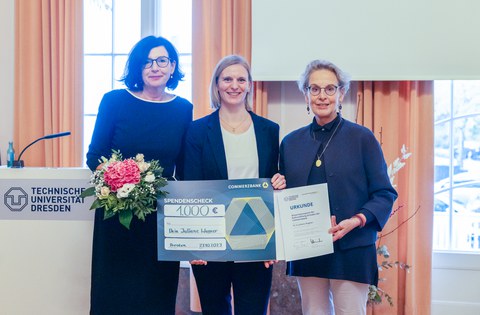
Von links: Beate Sopart als Vertreterin der Geschäftsleitung der Commerzbank AG Dresden, Preisträgerin Dr. Juliane Wagner, Fakultät Bauingenieurwesen, Prof. Dr. Ursula Staudinger, Rektorin der TU Dresden. Foto: Oliver Killig
Für ihre Dissertation „Zum Tragverhalten von Carbonbeton unter Ermüdungsbeanspruchung“ hat Dr. Juliane Wagner am 27. Oktober den Dissertationspreis der Kulturstiftung Dresden der Commerzbank erhalten. Die feierliche Verleihung erfolgte durch die Rektorin der TU Dresden, Prof. Dr. Ursula Staudinger und Beate Sopart als Vertreterin der Geschäftsleitung der Commerzbank AG Dresden im Rahmen einer Festveranstaltung im Festsaal des Rektorats. Der Preis ist mit 1000 Euro dotiert.
Newsbericht: Dissertationspreis der Kulturstiftung Dresden der Commerzbank
Kurt-Beyer-Preis 2022
Dr. Oliver Steinbock (Fakultät Bauingenieurwesen) erhält für seine Dissertation: "Verstärkung von Stahl- und Spannbetonbrücken mit Carbonbeton" den Kurt-Beyer-Preis 2022.
Newsbericht: Kurt-Beyer-Preis 2022
fib Medal of Merit für Prof. Manfred Curbach
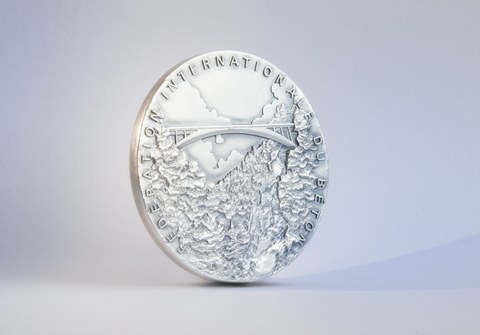
fib Medal of Merit 2023
Die fib – International Federation for Structural Concrete – Fédération Internationale du Béton verleiht zum Auftakt der Ulmer Betontage 2023 die fib Medal of Merit an Prof. Manfred Curbach – in Anerkennung seiner herausragenden Beiträge zum konstruktiven Betonbau und zur fib.
Lehrpreis 2022
Am 14.12.2022 im Rahmen der Senatssitzung erhielten Prof. Steffen Marx, Peter Betz und Conrad Pelka für die Vorlesung und das angebotene Seminar „Verstärken von Massivbauwerken“ den Lehrpreis 2022.
Newsbericht: Lehrpreis 2022
Innovationspreis 2021 des Industrieclub Sachsen e. V. für Oliver Steinbock
Am 15.11.2022 wurde der Innovationspreis 2021 an Dr.-Ing. Oliver Steinbock verliehen, er ist der stolze 30. Preisträger. Er erhielt den mit 5000 Euro dotierten Preis für seine Doktorarbeit an der TU Dresden, in der er erforscht hat, wie man mit Hilfe von Carbonbeton baufällige Brücken sanieren kann.
Newsbericht: Innovationspreis 2021für Oliver Steinbock
Kurt-Beyer-Preis 2021
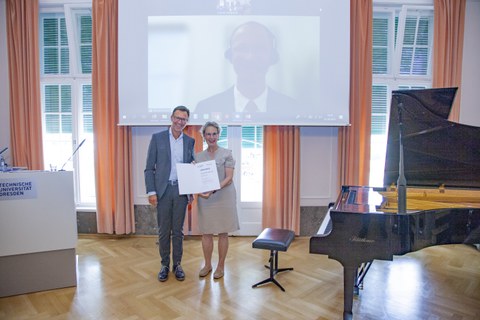
Adrian Diaconu (Vertretung Hochtief bzw. Stifter des Preises), Rektorin und Preisträger Dr. Michael Frenzel, Fakultät Bauingenieurwesen, per Videokonferenz
Dr. Michael Frenzel (Fakultät Bauingenieurwesen) erhält für seine Dissertation „Zum Tragverhalten von leichten, geschichteten Betondecken“ den Kurt-Beyer-Preis 2021. In der Arbeit wird ein Überblick über den aktuellen Entwicklungsstand und die bereits vorliegenden Forschungsarbeiten zu geschichteten, sandwichartigen Betondecken gegeben. Sie geht auf die Eigenschaften von Beton, Stahl und Stahlbeton und ausführlich auf den Verbund zwischen Betonschichten ein, der die Tragfähigkeit geschichteter Betondecken besonders beeinflusst. Anschließend werden verschiedene Bauteilzustände erläutert und die Versagensarten, die bei geschichteten Elementen auftreten können, vorgestellt. Dazu gehören maßgeblich das Biegezug- und Biegedruckversagen sowie das Biegeschub- und Fugenversagen. Es werden sowohl Formeln zur Berechnung von Durchbiegungen im Gebrauchszustand als auch von Bruchlasten in Abhängigkeit der Versagensart bereitgestellt. Auch sind Rechenansätze zur Beurteilung des Bauteilzustandes infolge des unterschiedlichen Schwindens der Betone aufgeführt.
Brücke aus Carbonbeton ausgezeichnet: zweifache Ehrung des Bauwerkes durch Fédération internationale du béton (fib)
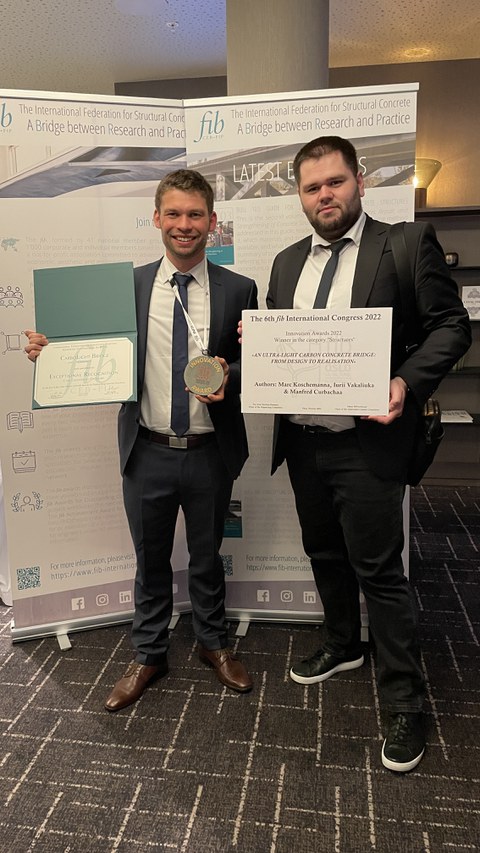
Marc Koschemann, Iurii Vakaliuk (v.n.l.r.) präsentieren stolz die Urkunden
Oslo/Dresden: Sie trägt den Namen CarboLight Bridge und vereint schlankes Design und Ressourceneinsparung. Angefertigt und konzipiert wurde die Brücke aus Carbonbeton und Infraleichtbeton speziell für das Deutsche Museum durch Wissenschaftler:innen des Institutes für Massivbau der TU Dresden. Die Brücke hat ihren Platz in der mit der Generalsanierung neu gestalteten Abteilung Brücken- und Wasserbau des Deutschen Museums eingenommen und präsentiert die Vorteile der innovativen Materialkombination eindrucksvoll.
Die Brücke erhielt im Rahmen des fib Kongresses, der vom 12. bis 16. Juni 2022 in Oslo stattfand gleich zwei Auszeichnungen: den Sonderpreis Exceptional Recognition im Wettbewerb „Award for Outstanding Concrete Structures“ sowie den Innovation Award 2022 in der Kategorie „Structures“ für das Paper „An ultra-light Carbon Concrete Bridge: From Design to Realisation“ der Autoren Marc Koschemann, Iurii Vakaliuk und Manfred Curbach.
Newsbericht: CarboLight Bridge erhält Auszeichnung
Preis der Bauindustrie Ost für Josiane Giese
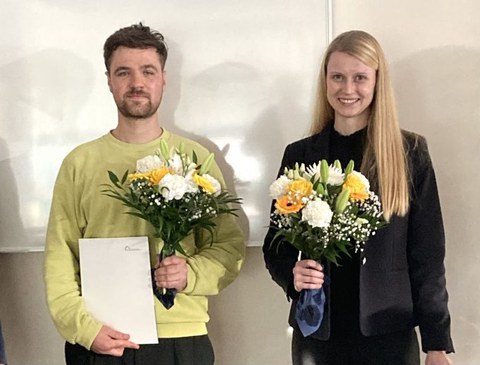
Die Preisträger in der Kategorie “Architektur” Quentin Pagés und in der Kategorie „Bauingenieurwesen“ Josiane Giese
Als ein wichtiges Signal der Zukunftssicherung verlieh der Bauindustrieverband Ost e. V. auch in diesen besonders schwierigen Corona-Zeiten seinen Branchenpreis an Absolvent:innen im Bereich des Bauingenieurwesens und der Architektur im Rahmen der verbandsinternen Sitzung des Ausschusses für Personalentwicklung am 9. November 2021 in Leipzig. Mit dem Preis in der Kategorie Bauingenieurwesen wurde Josiane Giese für ihre Diplomarbeit „Experimentelle Untersuchung einer carbonbetonverstärkten Plattenbrücke“ gewürdigt. Der Nachweis der Leistungsfähigkeit von Carbonbeton wurde bei der Verstärkung eines Brückenbauwerks erbracht und die Wirksamkeit der Ertüchtigungsmaßnahme nachgewiesen. Die erfolgreiche Anwendung der Carbonbetonverstärkung im Brückenbau ist ein wichtiger Beitrag für die weitere Forschung und Etablierung dieser Bauweise in der Praxis dar.
Ehrennadel 2020 für Prof. Manfred Curbach
Am 04.10.2021 erhielt Prof. Manfred Curbach im Rahmen des Mitarbeiterfestes eine goldene Ehrennadel 2020 der TU Dresden. Auf dem Gebiet des Textil- und Carbonbetons hat Manfred Curbach Pionierarbeit geleistet und er verantwortete mit großem Erfolg eine Amtsperiode des Prorektorats Universitätsentwicklung der Technischen Universität Dresden. Prof. Manfred Curbach steht gleichermaßen für Interdisziplinarität, Internationalität und erfolgreichen Technologietransfer. Mit den goldenen Ehrennadeln werden Mitglieder TU Dresden geehrt, die sich durch außergewöhnliche Verdienste und durch besondere Einzelleistungen um das Wohl der Universität verdient gemacht haben.
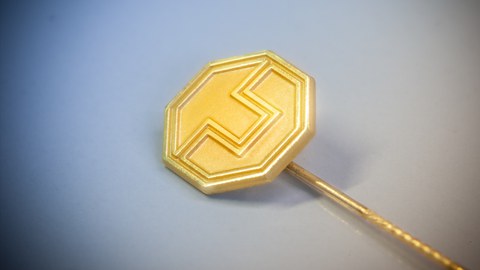
Goldene Ehrennadel 2020 der Technischen Universität Dresden
Preis der Bauindustrie Sachsen für herausragende Abschlussarbeiten im Bereich des Bauingenieurwesens und der Architektur 2020
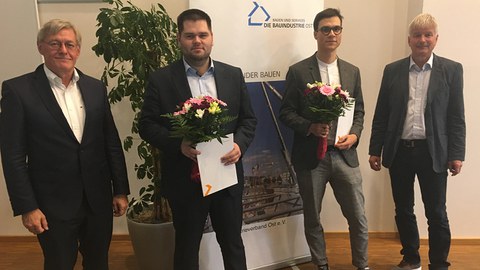
Der „Preis der Bauindustrie Sachsen“ für herausragende Abschlussarbeiten im Bereich des Bauingenieurwesens und der Architektur geht 2020 an Iurii Vakaliuk (Institut für Massivbau, TU Dresden) und Robert Bretschneider (TU Dresden).
Der „Preis der Bauindustrie Sachsen 2020“ im Teilbereich Bauingenieurswesen wurde verliehen an Iurii Vakaliuk vom Institut für Massivbau an der TU Dresden für seine Masterarbeit zum Thema „Konzeptionelle Entwicklung für die Anordnung von modularen textilbewehrten Makrozellen“.
Zur Begründung führt Finck aus: „Die Arbeit im Bereich Bauingenieurswesen zeigt ein sehr gutes Konzept zur Reduzierung der Gesamtbaukosten, insbesondere zur Verringerung des Materialvolumens von Beton, auf. Der alle zwei Jahre ausgelobte „Preis der Bauindustrie Sachsen“ ist mit 2.000 Euro dotiert.
Kurt-Beyer-Preis 2018
Was haben ein Unterwasser-Druckgehäuse aus Beton für die Erkundung der Tiefsee und eine Luftschiffhalle für den Bau von Zeppelinen gemeinsam? Beides sind Themen von außergewöhnlichen Dissertationen, die am 22. Mai 2019 an der TU Dresden mit dem Kurt-Beyer-Preis ausgezeichnet wurden.
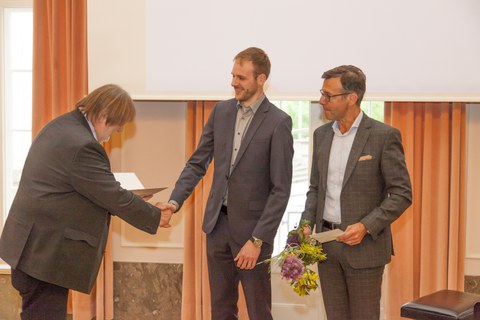
Der Prorektor für Forschung der TU Dresden, Prof. Dr. rer. nat. habil. Gerhard Rödel und Dipl.-Ing. Adrian Diaconu von der Hochtief Infrastructure GmbH NL Deutschland Südost gratulieren Dr. Sebastian Wilhelm.
Dr. Sebastian Wilhelm untersuchte in seiner Dissertation (Einsatz von UHPC-Druckgehäusen zum Schutz vor extremen Umgebungsbedingungen in der Tiefsee (Prädikat: „summa cum laude“, Betreuer: Prof. Manfred Curbach, TUD-Fakultät Bauingenieurwesen)), wie sich ultrahochfester Beton für Unterwasser-Druckgehäuse eignet. Ziel war es, eine kostengünstige und dauerhafte Alternative zu teuren Gehäusen aus Titan zu schaffen. Mit Unterwasser-Druckgehäusen wird die Tiefsee erforscht – eine Welt reich an Bodenschätzen, die als unbekannter als der Mond gilt. Er entwickelte am Institut für Massivbau ein wiederverschließbares Druckgehäuse aus UHPC für den Einsatz bis in 3.000 m Tiefe und analysierte u. a. das zeitabhängige Materialverhalten, die Durchlässigkeit und die Dauerhaftigkeit von UHPC. Die Versuche wurden numerisch simuliert. Aus den Messdaten kalibrierte Dr. Wilhelm ein Materialmodellgesetz. Er konnte nachweisen, dass Betondruckgehäuse mit 35 mm Wandstärke und 250 mm Außendurchmesser kurzzeitig sogar einem Druck von 60 MPa, das entspricht 6000 m Wassertiefe, standhalten. In der Praxis konnte Dr. Wilhelm mit dem Druckgehäuse bereits eine einjährige Tiefsee-Feldstudie in der Arktis realisieren.
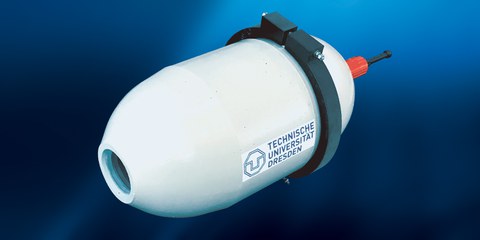
Betondruckgehäuse mit verklebter Saphirglasscheibe
Neben Dr. Sebastian Wilhelm wurde Dr. Roland Fuhrmann für seine Dissertation "Dresdens Tor zum Himmel – Die erste aerodynamisch geformte Luftschiffhalle und ihr Einfluss auf die Baugeschichte" mit dem Kurt-Beyer-Preis 2018 ausgezeichnet.
Der Kurt-Beyer-Preis wurde am 22. Mai 2019 im Festsaal des Rektorats, Mommsenstraße 11, feierlich verliehen. Der mit 5.000 Euro dotierte Kurt-Beyer-Preis wurde in diesem Jahr bereits zum 23. Mal vergeben. Seit 1996 stiftet die HOCHTIEF Infrastructure GmbH die Dotierung für diesen Preis, mit dem herausragende TUD-Absolventen bzw. -Promovierte des Bauingenieurwesens bzw. der Architektur ausgezeichnet werden. Vom Stifter wurden bislang mehr als 100.000 Euro Preisgeld zur Verfügung gestellt.
Carl-Friedrich-Gauß-Medaille 2019
Die Braunschweigische Wissenschaftliche Gesellschaft (BWG) verleiht die Carl Friedrich Gauß-Medaille 2019 an Herrn Univ.-Prof. Dr-Ing. Dr.-Ing. E.h. Manfred Curbach, Direktor des Instituts für Massivbau der Technischen Universität Dresden, in Würdigung seiner Leistungen und Verdienste bei der Erforschung und Anwendung neuer Baustoffe und Bauweisen für den Betonbau.
Manfred Curbach ist einer der herausragenden Bauforscher dieser Zeit. Er hat besondere Leistungen für die Entwicklung der Bautechnik im Betonbau erbracht.
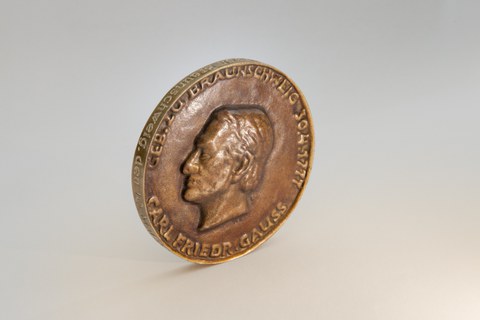
Carl-Friedrich-Gauß-Medaille 2019
Auf seine Impulse, seine Kreativität und seine begeisternde Überzeugungskraft sind maßgebliche moderne Entwicklungen zurückzuführen, wie die Textilbetonbauweise, wie der Paradigmenwechsel des Betonbaus von „schwer, massig, trist“ zu „filigran, leicht, elegant“ und wie die aktuelle Erforschung von Carbonbewehrung im Betonbau an Stelle von Stahlbewehrung.
Manfred Curbach versteht es in beeindruckender Weise, zukunftsweisende Forschungsthemen zu erdenken, zu realisieren, die Ergebnisse zu vermitteln, in die Baupraxis umzusetzen und dort zu erfolgreicher Anwendung zu begleiten. Durch seine Arbeiten werden maßgebliche Weichenstellungen für die Entwicklung des Bauens in der Zukunft zu verbesserter Leistungsfähigkeit, Ästhetik, Ressourcenschonung und Wirtschaftlichkeit ermöglicht.
Die Medaille wird im Rahmen der Feierlichen Jahresversammlung der BWG am 10. Mai 2019 um 16.00 Uhr in der Dornse des Altstadtrathauses der Stadt Braunschweig verliehen. Am Vormittag (9.30 Uhr) desselben Tages findet zu Ehren des Preisträgers im Bürgermeisterzimmer des Altstadtrathauses ein öffentliches Wissenschaftliches Kolloquium statt mit dem Thema „Bauen im Jahr 2050: Erfordernisse, Chancen, Ideen“.
Quelle: Pressemitteilung Braunschweigische Wissenschaftliche Gesellschaft
„Das ist etwas, was ich an unseren Vorgängern so bewundere. In außergewöhnlichen Momenten besaßen sie einen außergewöhnlichen Mut,
um eine Idee umzusetzen.“
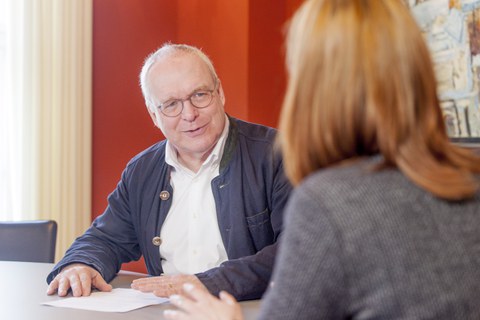
Prof. Dr.-Ing. Dr.-Ing. E. h. Manfred Curbach im Interview
Straßen asphaltieren, Wohnhäuser, Hochhäuser und Brücken bauen, bei Planungen öffentlicher Gebäude wie Sportstadien, Schwimmbädern oder Einkaufszentren beratend für die Prüfung der Statik dabei sein, vor Ort auf der Baustelle den Ton angeben – sehen so die typischen Tätigkeiten eines Bauingenieurs aus?
Eigentlich muss man dies ein wenig stärker differenzieren. Es gibt Bauwerke, bei denen Bauingenieure tatsächlich diejenigen sind, die entwerfen, die konstruieren, die rechnen und bei der Bauausführung maßgebend tätig sind. Das sind zum Beispiel Brücken, Straßen oder Industriebauwerke. Dann gibt es natürlich eine ganze Reihe von Gebäuden, bei denen sich Bauingenieur und Architekten die Arbeit teilen, z. B. bei Hochhäusern. Die Entwürfe stammen in der Regel von Architekten, die auch die Detailplanung machen. Die statische Berechnung und Konstruktion werden von Bauingenieuren durchgeführt. Die Aufgaben im Zuge der Bauleitung, Kalkulation, Abrechnung eines Bauingenieurs in einem Unternehmen finden im Büro statt. Ein weiteres wichtiges Aufgabenfeld eines Bauingenieurs ist die Kontrolle der Statik anderer als Prüfingenieur. Diese haben sich zusätzlich zur Grundausbildung zum Bauingenieur weitergebildet, bereits eine Menge Erfahrung und Kenntnisse und eine sogenannte Prüflizenz bekommen, um die Statik anderer prüfen zu können. Dann haben wir viele Bauingenieure in der öffentlichen Verwaltung, die Ausschreibungen vorbereiten, frühe Planungsphasen begleiten und natürlich hinterher auch kontrollieren, ob das gebaut wurde, was sie bestellt haben und auch abnehmen. Und dann gibt es noch Bauingenieure in der Wissenschaft.
Inspiriert durch die Schweizer Bauingenieure Robert Maillart und Christian Menn, bildeten Langlebigkeit, Ästhetik, Leichtigkeit und Ressourcenschonung das Tragwerk Ihrer damaligen Zukunftsvision. Wie hat sich diese Zukunftsvision entwickelt?
Anfang der 1980er Jahre war ich für einen Auslandskurs in Princeton/USA und der dortige Gastprofessor war Christian Menn, damals Professor an der ETH Zürich. Als ich dort war, hielt er gerade eine Vorlesungsreihe und hat z.B. über die Brücken von Robert Maillart geredet, aber natürlich auch über seine eigenen Ideen (Anmerkung der Redaktion: Christian Menn erhielt 1998 ebenfalls die Gauß-Medaille) Er hat mich, was Entwurf und Konstruktion von Brücken angeht, sehr geprägt. Herr Menn hatte ziemlich radikale Ideen. Das begann damit, dass er sagte „Eine schöne Brücke zu bauen muss nicht teurer sein als eine schlecht gestaltete Brücke“. Man braucht also nicht Geld um schön zu bauen, sondern eher Geist. Jede Brücke verlangt nach ihrem eigenen Stil in Abhängigkeit von der Umgebung, in der sie gebaut wird. Und es muss immer ein Gleichgewicht geben, nicht nur zwischen den Kräften – das ist selbstverständlich – auch zwischen der Struktur, der Form und der Last, die abgetragen werden soll. Das ist nicht automatisierbar, das kann kein Computer. Ich sehe nur, das eben sehr viel gebaut wird, was diesen Regeln nicht unbedingt entspricht. Es gibt eine Art Standard-Querschnitt und Standard Statisches System, das gerne immer wieder angewendet wird und teilweise zu durchaus plumpen Brücken führt.
Bleiben wir beim Brückenbau: Welche Ziele stehen bei Ihnen noch auf der Agenda?
Wenn ich mir meine eigenen Brücken so anschaue, dann hält sich das schwer in Grenzen. Meine Wirkung ist oft eher eine mittelbare. Studierende so auszubilden, dass sie dieses Bewusstsein möglichst frühzeitig mitbekommen und dann in Zukunft hoffentlich schönere Brücken bauen. Da würde ich mich eher als Lehrer sehen und weniger als Ausführender.
Termine, Meetings, Dienstreisen, Konferenzen, Abstimmungen – was motiviert sie und wie gelingt Ihnen dieser Kraftakt?
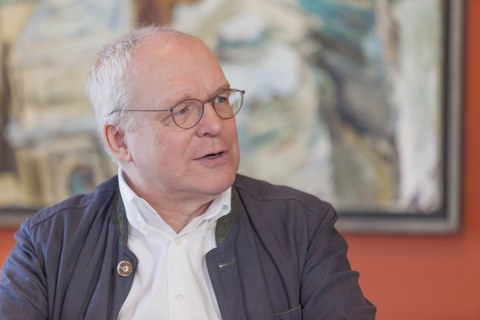
Prof. Dr.-Ing. Dr.-Ing. E. h. Manfred Curbach im Interview
Das ist schwer zu beantworten! Ein Grund könnte sein, der aber gleichzeitig ein großes Handicap ist, dass ich mich für sehr viele Dinge interessiere. Wenn man neugierig ist, dann möchte man wissen was Kollegen und Mitarbeiter auf dem Herzen haben. Sie haben alle auch gute Ideen und es wäre natürlich schade wenn das hinten herunterfallen würde. Es ist diese Neugier als Grundeigenschaft, deswegen auch Geschichte und zukünftige Materialien in einem. Wir haben ein wichtiges Forschungsvorhaben am Institut zur Geschichte eines zu Unrecht nicht so bekannten Bauingenieurs, der hier in Dresden gewirkt hat – Willy Gehler. Er ist nach dem 2. Weltkrieg fast in Vergessenheit geraten, er durfte nicht mehr erwähnt werden, hat aber in der ersten Hälfte des Jahrhunderts unglaubliche Leistungen erbracht, von den wir heute noch zehren. Auf der anderen Seite versuchen wir ein Material zu entwickeln, das die Zukunft bestimmt – den Carbonbeton.
Welches bestehende Bauwerk auf der Welt begeistert Sie besonders und warum?
Es gibt so einige Brücken von Maillart, die fast so vollkommen sind, dass sie heute noch mit den vorhandenen Materialien kaum nachgebaut werden können. Mit hochfestem Beton oder mit Carbonbeton schaffen wir es vielleicht wieder, so schöne schlanke Brücken zu bauen. Das hat Maillart damals mit dem ordinären Stahlbeton geschafft. Die Salginatobelbrücke wird von vielen gern als besonderes Bauwerk benannt. Eine, die mich schon immer fasziniert hat, ist die Brooklyn Bridge in New York. Und das eigentlich mehr aufgrund der Historie und der damaligen Bedeutung. Entworfen wurde sie von Johann Roebling, geboren in Mühlhausen in Thüringen, oder wie er später in den USA hieß John August Roebling. Mit etwa 25 Jahren ist er ausgewandert. Im Staat New Jersey hat er angefangen eine Fabrik zum Spinnen von Seilen aufzubauen. Er war wirtschaftlich schnell erfolgreich. Dann kam er auf die Idee, diese Seile im Brückenbau zu verwenden und hat einige Brücken gebaut, z. B. in Pittsburgh oder die erste dauerhafte Eisenbahn- und Straßenbrücke über den Niagara River. Sein größter Entwurf war dann die Brooklyn Bridge, den er noch selber angefertigt hatte. Zur Fertigstellung 1883 war sie die am weitesten gespannte Hängebrücke weltweit, auf Mauerwerkstürmen aufgehängt mit einer ganz leichten Fahrbahn aus Metall und Holz. Nach seinem Tod hat sein Sohn Washington, ebenfalls Bauingenieur, die Brücke weiter gebaut. Das ist eine Brücke, die so eng mit der Familie Roebling verbunden ist und eine solche Leistung für die damalige Zeit darstellt. Technisch ist ja inzwischen vieles möglich. Aber damals ohne die Kenntnisse eine derartige Brücke zu bauen, erfordert einen ungeheuren Mut. Das ist etwas, was ich an unseren Vorgängern so bewundere. In außergewöhnlichen Momenten besaßen sie einen außergewöhnlichen Mut, um eine Idee umzusetzen.
Wenn Sie eine Brücke Ihrer Wahl bauen dürften – wie sieht sie aus, wo steht sie und wen verbindet sie miteinander?
Was uns jetzt gerade umtreibt sind Brücken aus Carbonbeton, die den Vorteil haben, dass sie deutlich weniger Beton brauchen und damit erheblich schlanker sein können. Ich wünsche mir, dass es irgendwann mal Brücken aus Carbonbeton gibt, die in der Tradition von Robert Maillart stehen. Er baute schon vor über 100 Jahren Brücken, die diese Schlankheit aufweisen und letztlich auch die Dauerhaftigkeit, die mit dem Carbonbeton noch größer sein könnte. Wo sie einmal stehen könnte weiß ich nicht, denn es muss den richtigen Ort geben. Man musst erst den Standort sehen, um sagen zu können, welche Brücke an diese Stelle passt. Brücken verbinden Menschen miteinander.
Seit rund 25 Jahren entwickeln Sie Carbonbeton mit, um den globalen Herausforderungen unserer Zeit wie Bevölkerungswachstum und nachhaltiges Wirtschaften mit Ressourcen zu begegnen. Woher kommt diese Faszination für Carbonbeton und wie ist es Ihnen möglich, diese seit so langer Zeit aufrecht zu erhalten?
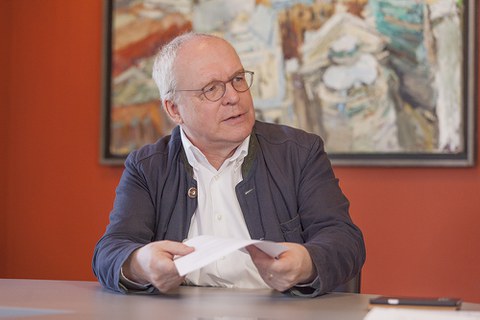
Prof. Dr.-Ing. Dr.-Ing. E. h. Manfred Curbach im Interview
Als das vor 25 Jahren begann, ahnte ich noch nicht, welche Ausmaße das annehmen kann. Aber mir war sofort klar, dass dies eine Kombination ist, die Zukunft hat. Wir haben damals bei Sanierungsmöglichkeiten mit dünnen Schichten eine Nische gesehen. Das es dann über die Jahre immer mehr wurde, überrascht mich nach wie vor. Mittlerweile würde ich sagen, dass der Carbonbeton das Zeug hat, den Stahlbeton in einem beträchtlichen Anteil zu ersetzen. Das erklärt vielleicht ein bisschen, weshalb wir da immer noch daran arbeiten. Es gibt einen Druck hinter dem Ganzen, weil wir mit dem Stahlbeton nicht so weiter bauen können wie bisher. Das verbraucht viel zu viele Ressourcen. Sand wird mittlerweile knapp, auch in Deutschland. Selbst an Orten, an denen wir noch Sand haben, darf man ihn nicht abbauen. Das heißt, wir müssen mit dem Material, was wir haben, sehr viel sparsamer umgehen. Da wir aber nicht weniger u. a. aufgrund der Bevölkerungsentwicklung bauen können, bleibt uns nichts Anderes übrig, als etwas wie Carbonbeton zu verwenden.
Das Dresdner Brückenbausymposium findet 2020 bereits zum 30. Mal statt. Gibt es dann eine große Torte aus Carbonbeton? Spaß beiseite – was ist für das Jubiläum geplant, gibt es da bereits Ideen?
Wir hatten vor vier Jahren das 25-jährige. Das haben wir ein bisschen gefeiert. Der Tagungsband war statt dem gängigen TUD-Blau in Silber. Zum 50. können dann die Veranstalter vielleicht einen goldfarbenen Umschlag wählen. Für das 30. ist bisher nichts Größeres geplant. Am Vorabend wird bereits zum 8. Mal der Deutsche Brückenbaupreis verliehen. Dieser wird alle zwei Jahre vergeben und ist mittlerweile auch schon wieder zu einer kleinen Tradition geworden.
Die Gauß-Medaille, benannt nach dem Braunschweiger Mathematiker, der in jüngerer Zeit auch den 10 DM-Schein schmückte. Was bedeutet diese Auszeichnung für Sie, die bereits zum 70. Mal verliehen wird?
Das kann ich am ehesten daran festmachen, wenn ich schaue, wer den Preis bisher bekommen hat. Diese Medaille richtet sich ja an fast alle Wissenschaftsbereiche. Letztes Jahr war es der Verfassungsrichter Paul Kirchhof, 2017 die Meeresforscherin Antje Boetius, 1998 Christian Menn – ich empfinde das als sehr, sehr große Auszeichnung, in diese Gruppe von Menschen mit aufgenommen zu werden.
Das Interview führten Diana Uhlmann und Stefan Gröschel
„Innovationspreis Bautechnik 2019“ des DBV
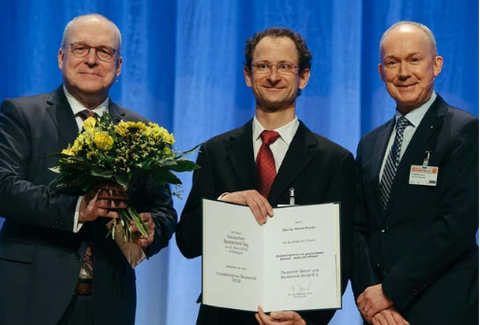
Foto zeigt den Gewinner des „Innovationspreis Bautechnik 2019“, Dipl.-Ing. Michael Frenzel, mit DBV- Vorsitzendem Dr. Jacob (rechts) und Vorsitzendem des Preisgerichts Professor Curbach (links) bei der Preisverleihung am 8. März 2019 in Stuttgart
Michael Frenzel von der Technischen Universität Dresden gewinnt „Innovationspreis Bautechnik 2019“ des DBV Dipl.-Ing. Michael Frenzel ist der Gewinner des diesjährigen „Innovationspreis Bautechnik“, der vom Deutschen Beton- und Bautechnik-Verein E.V. (DBV) am 8. März 2019 in Stuttgart verliehen wurde. Mit seiner Forschungsarbeit „Deckentragwerke aus geschichteten Betonen – leicht und effizient“ und seinem fundierten Vortrag überzeugte Michael Frenzel beim „Kolloquium für Jungingenieure“ am 7. März 2019 in Stuttgart das Preisgericht und gewann damit den „Innovationspreis Bautechnik 2019“. Um insbesondere junge Studierende und Promovierende zu fördern, stiftet der Deutsche Beton- und Bautechnik-Verein E.V. (DBV) alle zwei Jahre den „Innovationspreis Bautechnik“, der beim Deutschen Bautechnik-Tag vergeben wird. Die Urkunde überreichte der DBV-Vorsitzende Dr. Matthias Jacob gemeinsam mit Professor Manfred Curbach, dem Vorsitzenden des Preisgerichts, am 8. März 2019 in Stuttgart. Der Preis ist mit einem Preisgeld von 2.500 € dotiert. Üblicherweise werden Betondecken mit einem hohen Material- und Energieverbrauch ausgeführt. Um Deckentragwerke nun gewichtsreduziert und ressourcenschonend herstellen zu können, entwickelt Michael Frenzel im Rahmen seiner Dissertation an der Technischen Universität Dresden querschnitts- und formoptimierte Konstruktionen. Doch nicht nur das effiziente Tragverhalten berücksichtigte er in seiner Arbeit „mit einem hohen Maß an Kreativität“, sondern auch die Ästhetik. Die Forschungsarbeit fertigt Michael Frenzel bei Professor Manfred Curbach am Institut für Massivbau der Technischen Universität Dresden an. Die Dissertation basiert auf seiner Forschungsarbeit innerhalb des Teilprojekts „Leichte Deckentragwerke aus geschichteten Hochleistungsbetonen“ des von der DFG-geförderten Schwerpunktprogrammes SPP 1542 „Leicht Bauen mit Beton
Insgesamt präsentierten 11 Bauingenieurinnen und Bauingenieure ihre Masterarbeit oder Dissertation am 7. März 2019 im „Kolloquium für Jungingenieure“ und stellten sich den Fragen des Preisgerichts. Aus diesem starken Bewerberfeld setzte sich Michael Frenzel durch.
Preisgericht
Vorsitzender Prof. Dr.-Ing. Dr.-Ing. E.h. Manfred Curbach,
Technische Universität Dresden
Mitglieder
- Dr.-Ing. Hubert Bachmann, Ed. Züblin AG
- Prof. Dr.-Ing. Harald Garrecht, Universität Stuttgart
- Dr.-Ing. Julian Meyer, HOCHTIEF Engineering GmbH
- Prof. Dr.-Ing. Christoph Motzko, Technische Universität Darmstadt
- Dipl.-Ing. (FH) Franz Josef Zweier, Max Bögl Stiftung & Co. KG
Quelle: DEUTSCHER BETON- UND BAUTECHNIK-VEREIN E.V.
Emil-Mörsch-Denkmünze 2019
Der 1898 gegründete Deutsche Beton- und Bautechnik-Verein E.V. (DBV) hat am 7. März 2019 Prof. Dr.-Ing. Dr.-Ing. E.h. Manfred Curbach mit der Emil-Mörsch-Denkmünze geehrt, der höchsten Auszeichnung des Vereins. Die Verleihung durch den neuen DBV-Vorsitzenden Dr. Matthias Jacob erfolgte im Rahmen der Eröffnungsveranstaltung des Deutschen Bautechnik-Tages 2019 in Stuttgart.
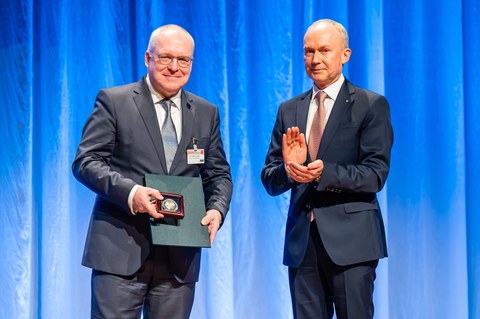
Prof. Dr.-Ing. Dr.-Ing. E.h. Manfred Curbach wird mit der Emil-Mörsch-Denkmünze ausgezeichnet.
Die Laudatio und Urkunde würdigten Manfred Curbach wie folgt: „Als begeisternder Lehrer, als inspirierender Forscher und kreativer Ingenieur hat er Herausragendes geleistet und dem Betonbau neue Impulse gegeben. Stets lässt er Menschen in einer Vielzahl nationaler und internationaler Fachvereinigungen und in der Gesellschaft an seinem Wissen teilhaben. Von besonderer Bedeutung sind seine innovativen Ideen zur Entwicklung von Carbonbeton, die auch außerhalb der Fachwelt bemerkenswerte Anerkennung finden. Wichtige Beiträge zum Impaktverhalten von Beton, zu mehraxialen Beanspruchungen, zum Massivbrückenbau sowie zur Geschichte des Betonbaus runden sein Schaffen ab. Durch sein Wirken hat er in der Tradition Emil Mörschs das Ansehen des Bauingenieurs in Fachwelt und Gesellschaft weit über die deutschen Grenzen hinaus gemehrt.“
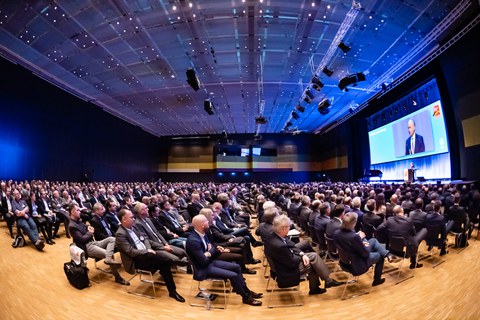
Eröffnungsveranstaltung DEUTSCHER BAUTECHNIK -TAG 2019
Geboren 1956 in Dortmund, begann Manfred Curbach 1977 das Studium des Bauingenieurwesens an der Universität Dortmund und schloss es als Diplom-Ingenieur im Jahr 1982 ab. Als Stipendiat der Studienstiftung des Deutschen Volkes führte ihn ein Studienaufenthalt an die Universität Princeton in den USA. 1987 wurde Manfred Curbach bei Professor Eibl in Karlsruhe zum Doktor der Ingenieurwissenschaften promoviert. Es folgte der Wechsel in die Praxis, in das Ingenieurbüro Köhler + Seitz in Nürnberg von 1988 bis 2004. Im Jahr 1994 erhielt er den Ruf an die Technische Universität Dresden und wurde dort Professor für Massivbau.
Die Forschungsschwerpunkte von Manfred Curbach sind das Materialverhalten von Beton unter hohen Belastungsgeschwindigkeiten und das Verhalten von Betonbauteilen unter Kurzzeitdynamik. Zudem forscht er an der mehraxialen Festigkeit von Beton, zum Verbundverhalten zwischen Hochleistungsbeton und Bewehrungsstahl und zwar unter Ermüdungsbeanspruchung. Insbesondere für die Leistungen auf diesen Themenfeldern wurde ihm 2011 die Ehrendoktorwürde durch die Technische Universität Kaiserslautern verliehen. Zahlreiche weitere Preise und Auszeichnungen folgten in seiner Laufbahn.
Seit 2013 ist Manfred Curbach Sprecher des BMBF-Konsortiums C³ – Carbon Concrete Composite. Seine Vision ist nichts Geringeres als eine neue Art des Bauens unter Verwendung von Carbonbeton. Dazu ersann, beantragte und gewann er mehr als 160 Partner für ein Forschungsprojekt mit einem Volumen von insgesamt fast 70 Millionen Euro. Und Manfred Curbach hat es geschafft, dieses Thema so darzustellen, dass nicht nur die Fachöffentlichkeit davon erfährt. 2016 erhielt er den „Deutschen Zukunftspreis, Preis des Bundespräsidenten für Technik und Innovation“ und setzte sich gegen Mitbewerber u. a. aus der Automobilbranche durch.
Neben seinen fachlichen Qualitäten wurde auch seine gewinnende und menschliche Größe gewürdigt. Als leidenschaftlicher Lehrer und echter Teamplayer teilt Manfred Curbach sein Wissen in zahlreichen Ehrenämtern, folgerichtig ist er beispielsweise Mitglied in der Nationalen Akademie der Wissenschaften Leopoldina.
Manfred Curbach bedankte sich beim DBV für die „riesengroße Auszeichnung“ sowie seinen Mitarbeitern und der Technischen Universität Dresden für die Zusammenarbeit und Unterstützung. Den Ingenieurnachwuchs forderte er auf, Verantwortung zu übernehmen und eigene, neue Wege zu gehen.
Der DBV stiftet seit 1938 im Turnus von zwei Jahren die Emil-Mörsch-Denkmünze zur Ehrung von Persönlichkeiten, die sich durch besondere Leistungen auf dem Gebiet des Betonbaus ausgezeichnet und diese Bauart gefördert haben.
2019 Manfred Curbach
2017 Jürgen Schnell
2015 Karl Morgen
2013 Hans-Wolf Reinhardt
2011 Holger Svensson
2009 Konrad Zilch
2007 Theodor Baumann
2005 Peter Schießl
2003 Wieland Ramm
2001 Gert König
1999 Josef Eibl
1997 Hubert K. Hilsdorf
1995 Jörg Schlaich
1993 René Walther
1991 Herbert Kupfer
1989 Franco Levi
1987 Volker Hahn
1985 Hanno Goffin
1983 Karl Kordina
1981 Hans Wittfoht
1979 Ben C. GerwickJr.
1977 Wolfgang Zerna
1975 Pieter Blokland
1973 Kurt Walz
1971 Hans Minetti
1969 Nicolas Esquillan
1967 Fritz Leonhardt
1965 Hermann Bay
1963 Pier Luigi Nervi
1961 Ludwig Lenz
1959 Eugène Freyssinet
1957 Hubert Rüsch
1956 Alfred Hummel
1955 Bruno Hampe
1954 Max Lütze
1953 Ulrich Finsterwalder
1952 Bernhard Wedler
1951 Adolf Kleinlogel
1950 Willy Gehler
1949 Walter Nakonz
1944 Karl Schaechterle
1943 Leopold Ellerbeck
1942 Fritz von Emperger
1941 Otto Graf
1940 Franz Dischinger
1939 Fritz Todt
1938 Emil Mörsch
Quelle: DEUTSCHER BETON- UND BAUTECHNIK-VEREIN E.V.
Wackerbarth-Medaille 2018
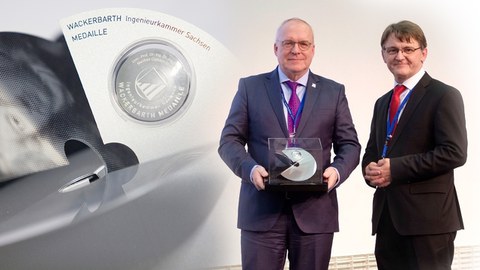
Prof. Manfred Curbach (links im Bild) erhält die Wackerbarth-Medaille von Prof. Dr.-Ing. Hubertus Milke, Präsident der Ingenieurkammer Sachsen.
Im Rahmen des Ingenieurkammertages 2018 erhielt Prof. Manfred Curbach, Institutsdirektor des Instituts für Massivbau an der TU Dresden, die "Wackerbarth-Medaille".
Mit dieser Auszeichnung würdigt die Ingenieurkammer Sachsen seine langjährige, über die Grenzen der Bundesrepublik hinaus anerkannte wissenschaftliche Arbeit sowie sein Engagement für das international anerkannte Brückenbausymposium.
Dresden Congress Award 2018
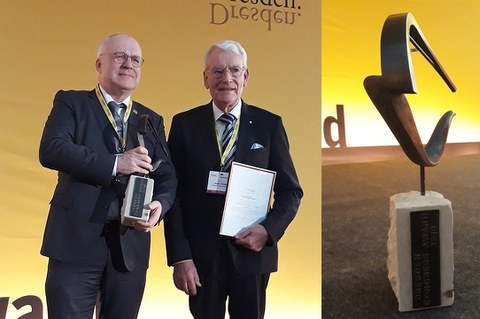
Prof. Manfred Curbach (links im Bild) und Prof. Jürgen Stritzke erhalten den Dresden Congress Award für das 28. Dresdner Brückenbausymposium 2018.
Bereits 1991 startete Professor Jürgen Stritzke mit einem Kongress über Brückenbau in Dresden. Im März kommenden Jahres findet das inzwischen 29. Dresdner Brückenbausymposium (DBBS) statt.
Das DBBS hat sich seit seinem Beginn immer als Multiplikator guter Ideen, interessanter Innovationen und erfolgversprechender Technologien verstanden und entwickelte sich zur größten Veranstaltung ihrer Art im deutschsprachigen Raum und ist ein idealer Treffpunkt für den Erfahrungsaustausch über Planung, Bauausführung, Instandsetzung und Ertüchtigung von Brücken für alle am Bau Beteiligten und Interessierten. Dieses Engagement für die große Familie derBrückenbauer*innen und auch für den Kongressstandort Dresden wurde am 15. November 2018 mit dem Dresden Congress Award in der Kategorie Kontinuität ausgezeichnet.
Der Dresden Congress Award - gern auch "Oscar der Kongressbranche" genannt, würdigt engagierte Wissenschaftler, Unternehmer und Kongressveranstalter, die Kongresse und Tagungen nach Dresden geholt und erfolgreich veranstaltet haben.
Preisverleihung Wolfgang-Dürr-Stiftung in Verbindung mit der WOLFF & MÜLLER Personalentwicklung GmbH 2018
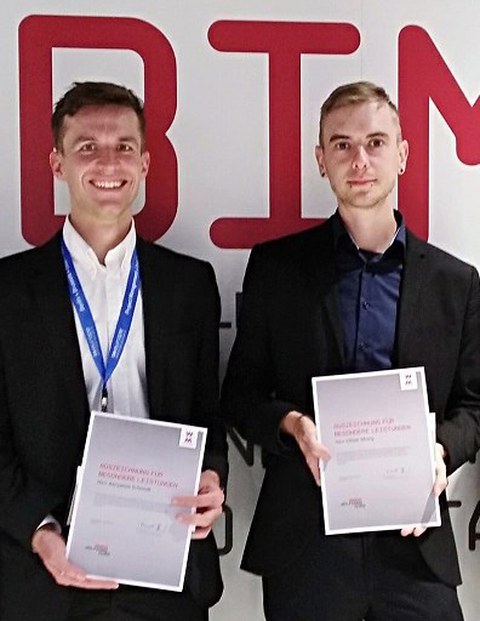
Benjamin Schmidt (links) und Oliver Mosig zur Preisverleihung in München
Am 10. Oktober 2018 erhielten auf der EXPO REAL (Internationale Fachmesse für Immobilien und Investitionen) in München zwei Absolventen unserer Fakultät – Herr Oliver Mosig und Herr Benjamin Schmidt – für ihre erstklassigen Studienleistungen und insbesondere herausragende Abschlussarbeiten von der Wolfgang-Dürr-Stiftung in Verbindung mit der WOLFF & MÜLLER Personalentwicklung GmbH eine Auszeichnung mit einem Preisgeld in Höhe von je 1000 Euro.
Deutscher Zukunftspreis 2016
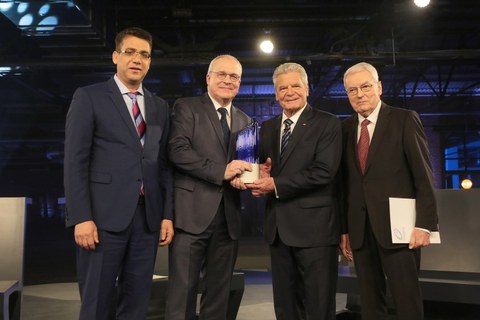
Die Dresdner Professoren Manfred Curbach, Chokri Cherif und Peter Offermann sind die Gewinner des Deutschen Zukunftspreises 2016.
Die Dresdner Professoren Manfred Curbach, Chokri Cherif und Peter Offermann sind die Gewinner des Deutschen Zukunftspreises 2016. Bundespräsident Joachim Gauck überreichte den mit 250.000 Euro dotierten Preis am 30. November in Berlin. Das Forscherteam der TU Dresden gehörte zu den drei Finalisten und konnte sich erfolgreich gegen seine Mitbewerber durchsetzen. „Zum ersten Mal in der Geschichte der Preisverleihung wurde ein Team aus dem Bereich des Bauwesens ausgezeichnet. Das zeigt uns, wie wichtig unsere Forschungen und unser Ansinnen sind, den so dringend notwendigen Paradigmenwechsel im Bauwesen herbeizuführen, hin zu mehr Ressourceneffizienz und Nachhaltigkeit“, so Professor Manfred Curbach, Direktor des Institutes für Massivbau der TU Dresden und Sprecher des Gewinnerteams. Der Deutsche Zukunftspreis des Bundespräsidenten gehört zu den wichtigsten Wissenschaftspreisen in Deutschland. Den Rektor der TU Dresden, Prof. Hans Müller-Steinhagen, freut es besonders: „Gratulation! Das ist ein großartiger Erfolg für die drei Professoren, für die TU Dresden und auch für den Wissenschaftsstandort Dresden. Damit gelingt es Wissenschaftlern unserer Universität nach 2011 bereits zum zweiten Mal, beginnend mit der Idee und der Grundlagenforschung bis hin zur Markteinführung, die Entstehung zukunftsweisender Innovation nachvollziehbar zu machen und so die hochkarätige Jury des Deutschen Zukunftspreises zu überzeugen.“
Die drei Forscher der TU Dresden entwickelten einen neuen Verbundwerkstoff, der statt einer Stahlbewehrung auf den Einsatz von Carbon setzt. Carbon ist viermal leichter und sechsmal tragfähiger als Stahl. Das Potenzial des innovativen Verbundwerkstoffes ist immens. Im Gegensatz zu Stahlbeton ist Carbonbeton widerstandsfähiger und gleichzeitig beständiger, da er nicht rostet. Bauteile und Bauwerke können dünner konstruiert werden, wodurch wertvolle Ressourcen, wie Wasser und Sand, gespart werden. Das Material lässt zudem filigrane Formen und vielfältige Einsatzbereiche zu. Beim Einsatz von Carbonbeton sind mehr als 50 Prozent Materialeinsparung möglich. Damit geht auch die Reduzierung des Energieverbrauchs und des CO2-Ausstoßes einher. Der Entwicklungsfortschritt liegt auch im Detail. Bauteile aus Carbonbeton ermöglichen eine Kombination mit Zusatzfunktionen, wie Dämmen, Heizen oder Überwachen von Gebäuden. Nicht nur im Bereich des Neubaus kann Carbonbeton eingesetzt werden. Das Material eignet sich auch hervorragend für die Verstärkung bestehender Bauwerke. Die Lebensdauer von Gebäuden, Brücken und Masten kann durch Auftragen einer dünnen Schicht Carbonbeton deutlich erhöht werden. Schon seit 2006 werden deutschland- sowie weltweit alte Bauwerke, wie ein Kaufhaus in Prag oder auch riesige Silos, wie die Zuckersilos in Uelzen, mit diesen Verfahren verstärkt. Der Baustoff Carbonbeton stellt also nicht nur eine Innovation für den Standort Dresden dar, sondern wird weltweit immer wichtiger.
Die Bedeutung der Carbonbeton-Technologie erkannte auch das Bundeministerium für Bildung und Forschung und fördert den 2014 gegründeten Verein C³ – Carbon Concrete Composite e. V. mit bis zu 43 Millionen Euro. Der C³ e. V. ist ein interdisziplinäres Netzwerk aus mehr als 150 Partnern aus den Bereichen Wirtschaft, Wissenschaft und Verbänden, die gemeinsam die Einführung des Materials auf dem Markt vorantreiben.
Gottfried-Brendel-Preis 2016
Der mit 3.000 Euro dotierte Gottfried-Brendel-Preis wird von einem der führenden Unternehmen der Branche gestiftet, der Bilfinger SE. Am 28.10.2016 hatte sich die Jury für zwei gleichwertige erste Preise und einen Sonderpreis entschieden, die Dr. Horst Arnold verlieh. Preisträger waren Kristina Farwig vom Institut für Massivbau für ihre Arbeit „Sanierung von Holzbalkendecken in Holz-Beton-Verbundbauweise“ sowie Cäcilia Karge vom Institut für Stahl- und Holzbau für ihre Arbeit „Entwurf und Bemessung einer Fußgänger- und Radfahrerbrücke über den Datteln-Hamm-Kanal und die Lippe in Hamm“. Den Sonderpreis erhielt Peter Friedrich vom Fakultätsrechenzentrum (FRZ) für seine Arbeit „Normalenvektorbasierte Verfahren der Sensitivitätsanalyse zur Validierung von Modellen der Versagensgrenzflächen dreiaxialer Betonbelastungsversuche“.
Kurt-Beyer-Preis 2016
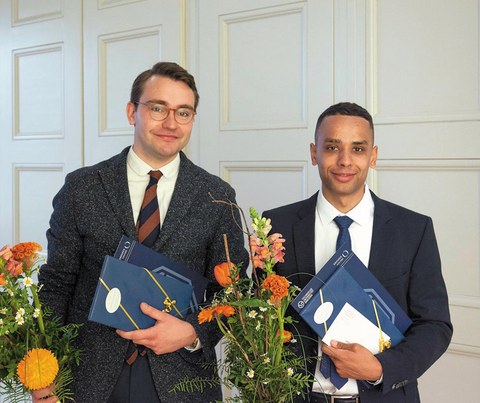
Die glücklichen Preisträger: Maximilian Kunze (li.) und Alexander Schumann (re.)
Am 21. April 2017 wurde im Festsaal des Rektorats der Kurt-Beyer-Preis 2017 verliehen. Jeweils ein Absolvent der Fakultät Architektur und der Fakultät Bauingenieurwesen erhielten den mit 2500 Euro dotierten Preis für ihre überragenden Diplomarbeiten.
Dipl.-Ing. Alexander Schumann vom Institut für Massivbau erarbeitete innerhalb seiner Diplomarbeit einen Entwurf einer freitragenden Halle aus Carbonbeton. Bei der Verwendung von Carbonbeton können schlanke und filigrane Tragelemente konzipiert werden. Zusätzlich zum Einsatzgebiet bei Fassadenelementen und Verstärkungsmaßnahmen für bestehende Gebäude ist Carbonbeton für filigrane neue Bauwerke, insbesondere Flächentragwerke wie Schalen, Faltwerke, Gitterschalen usw., prädestiniert. Die von Alexander Schumann entworfene Halle weist eine stützenfreie Überdachung in Form einer doppelt gekrümmten Schale mit einer lichten Raumhöhe von 8 m auf. Sie ist aus einzelnen vorgefertigten Textilbetonsegmenten, Rautenstäben und einer sich zwischen den einzelnen Rauten befindenden aussteifenden Textilbetonschicht gefertigt.
Somit ist ein optisch ansprechender Entwurf entstanden, der aus einer schlanken und filigranen Tragstruktur besteht, die komplett vorgefertigt werden kann. Der Entwurf zeigt, dass ein Wandel weg vom Massiven hin zu einem leichten und energieeffizienten Bauen durch Einsatz von Carbonbeton vollzogen werden kann.
Kurt-Beyer-Preis 2015
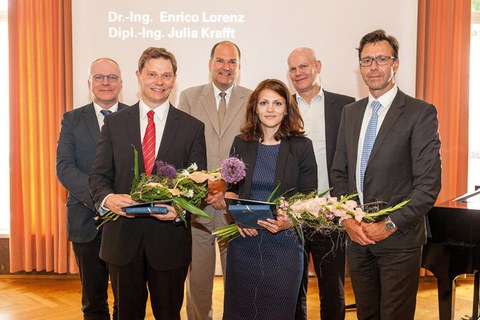
Die beiden Preisträger des Kurt-Beyer-Preises 2015 im Kreis der Laudatoren
Der Kurt-Beyer-Preis wurde am 10. Juni 2016 zum 20. Mal verliehen. Preisträger des Jahres 2015 sind Dr.-Ing. Enrico Lorenz vom Institut für Massivbau der Fakultät Bauingenieurwesen, der den Preis für seine Dissertation “Endverankerung und Übergreifung textiler Bewehrungen in Betonmatrices” erhält, und Dipl.-Ing. Julia Krafft aus der Fakultät Architektur für ihre Diplomarbeit ”Grenzwertig – Segelflugzentrum Lemwerder”.
Enrico Lorenz hat in akribischer wissenschaftlicher Kleinarbeit das Zusammenwirken von Betonmatrix und textiler Carbonbewehrung erforscht. Um herauszufinden, wie die textile Bewehrung sicher im Beton verankert und unter welchen Bedingungen ein Herausziehen aus der Betonmatrix verhindert werden kann, musste er ein noch unbekanntes wissenschaftliches Terrain betreten. Er tat dies zielsicher und, wie sein Doktorvater Prof. Manfred Curbach betonte, mit einer Kombination aus theoretischer Basis, experimenteller Fundiertheit und baupraktischer Anwendbarkeit. „Dieses Dreigestirn zeichnet Enrico Lorenz‘ Arbeit in besonderem Maße aus“, sagte Prof. Curbach.
Kurt-Beyer-Preis 2014
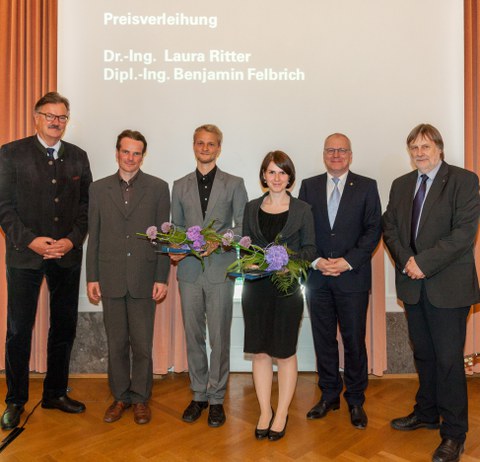
Preisverleihung – mit (v.l.n.r.) Dipl.-Ing. Stephan Otto vom Preis-Stifter HOCHTIEF, Dr.-Ing. Jörg Nönnig, Dipl.-Ing. Benjamin Felbrich, Dr.-Ing. Laura Ritter, Prof. Manfred Curbach und dem Prorektor für Forschung, Prof. Gerhard Rödel.
Seit 19 Jahren wird der Kurt-Beyer-Preis bereits verliehen – für die Besten aus den Bereichen Architektur und Bauingenieurwesen. Am 22. Mai 2015 erhielten in einer Festveranstaltung im Rektorat Dr.-Ing. Laura Ritter und Dipl.-Ing. Benjamin Felbrich als 43. und 44. Preisträger den von HOCHTIEF gestifteten Preis.
Laura Ritter wurde an der Fakultät Bauingenieurwesen promoviert, ihr nun ausgezeichnetes Thema war „Der Einfluss von Querzug auf den Verbund zwischen Beton und Betonstahl“. Der Laudator während der Feier war auch der Betreuer der Arbeit: Prof. Manfred Curbach vom Institut für Massivbau nannte die Arbeit „einen sehr wichtigen Meilenstein in der Verbundforschung“ und betonte, dass „die Forschungsergebnisse von Laura Ritter eine hervorragende Grundlage für alle weiteren theoretischen Analysen auf diesem Gebiet darstellen.“
Mit „Neugier, Feuereifer, echter Entdeckerlust und Forscherdrang“ sei Benjamin Felbrich seine Diplom-Arbeit angegangen, erzählte sein Betreuer (zusammen mit Sebastian Wiesenhüter) und Laudator Dr.-Ing. Jörg R. Nönnig – und schob schmunzelnd nach: „…und landete schon bald im unsicheren Terrain!“ Aber genau das, der Vorstoß an ungewisse Grenzen und das Austasten dessen, was hinter diesen Grenzen sei, habe schließlich zum Erfolg geführt. Die Kommission sei verblüfft und überrascht gewesen bei der Präsentation – aber eben auch überzeugt: Möglicherweise sei das, was Benjamin Felbrich mit seiner Arbeit „Bionik in der Architektur – Experimente mit Multiagentensystemen in irregulären Faltwerken“ angestoßen habe, ja die Zukunft von Architektur.
…eine Zukunft, der sich Dipl.-Ing. (FH) Stephan Otto von der Hochtief Construction GmbH zwar nicht verschließen wollte, sich aber bei seiner Festansprache dennoch nicht verkneifen konnte zu fragen: „Wie soll man das denn bauen?“ Aber das ist bei zukunftsweisender Forschung ja häufig der Fall, dass man im Jetzt mehr Fragen als Antworten hat (auch wenn die beiden Preisträger ihre Arbeiten sehr anschaulich vorgestellt hatten!). Dafür konnte Stephan Otto auf zahlreiche respektable Bauwerke verweisen, an denen HOCHTIEf derzeit beteiligt ist – durchaus verbunden mit dem Hinweis in eigener Sache, dass man an hervorragendem Nachwuchs sehr interessiert sei…
Wolfgang-Zerna-Ehrenmedaille 2014
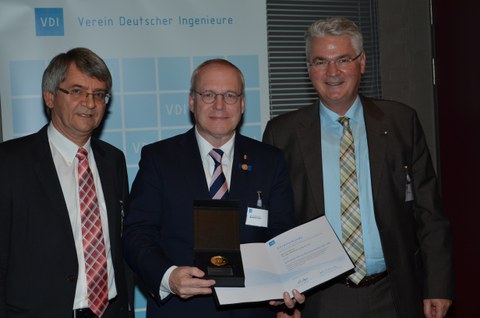
Prof. Manfred Curbach (Mitte) wurde im Beisein von Laudator Dr.-Ing. Franz-Hermann Schlüter und Prof. Wilfried Clauß, Vorsitzender der VDI-GBG, die neue Medaille verliehen.
Hervorragende Leistungen auf dem Gebiet der Bautechnik würdigt der VDI Verein Deutscher Ingenieure mit einer neuen Auszeichnung: Erstmals verlieh die VDI-Gesellschaft Bauen und Gebäudetechnik auf ihrer Jahrestagung die Wolfgang-Zerna-Ehrenmedaille. Preisträger ist Prof. Dr.-Ing. Manfred Curbach von der TU Dresden.
Geehrt wurde Curbach für seine besonderen wissenschaftlichen Leistungen auf dem Gebiet der Bautechnik. Dabei stellte Laudator Dr.-Ing. Franz-Hermann Schlüter, Mitglied im Fachbeirat Bautechnik, insbesondere den Betonbau als Betätigungsfeld heraus. Manfred Curbach war von 2003 bis 2008 Vorsitzender der damaligen VDI-Gesellschaft Bautechnik. In seiner Amtszeit wurde der erste VDI-Studentenwettbewerb zur Planung einer Rheinbrücke durchgeführt.
Die Wolfgang-Zerna-Ehrenmedaille des VDI wird von der VDI-Gesellschaft Bauen und Gebäudetechnik, in Würdigung der hervorragenden und beispielhaften Persönlichkeit des Namensgebers verliehen. Sie zeichnet besonders verdiente Mitglieder und ehrenamtlich Tätige oder Ingenieure aus, die sich auf den Gebieten der Bautechnik besondere Verdienste erworben haben.
Die Wolfgang-Zerna-Ehrenmedaille des VDI ist eine geprägte Goldmünze. Auf der Vorderseite trägt sie das Bildnis Wolfgang Zernas, dessen Name, Geburts- und Sterbejahr sowie die Umschrift „VDI – Bautechnik“, die Rückseite und die Miniaturausführung sind identisch mit der Ehrenmedaille des VDI. Die neue Auszeichnung ist der Ehrenmedaille und der Hermann-Rietschel-Ehrenmedaille des VDI gleichgestellt.
Quelle: VDI Verein Deutsche Ingenieure | Presse
Kurt-Beyer-Preis 2013
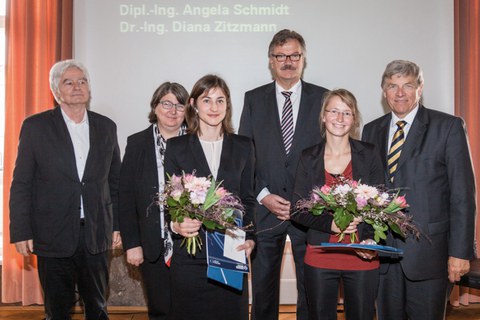
Stephan Otto, Angela Schmidt, Prof. Rainer Schach (v.l.n.r.).
Der Kurt-Beyer-Preis 2013 wurde am 21. März 2014 im Festsaal des Rektorats verliehen. Preisträgerinnen sind Dipl.-Ing. Angela Schmidt vom Institut für Massivbau, Fakultät Bauingenieurwesen, und Dr.-Ing. Diana Zitzmann, Fakultät Architektur.
Angela Schmidt erhielt den Preis für ihre Diplomarbeit “Formoptimierung von Stützen”. Sie hatte sich bereits im 9. Fachsemester im Rahmen ihrer Projektarbeit mit der Formoptimierung von Stützen beschäftigt. Dafür wurde sie bereits 2013 mit dem Brendel-Preis geehrt. Dem Thema der Projektarbeit blieb Angela Schmidt treu, indem sie es in ihrer Diplomarbeit weiter vertiefte. “Bei beiden Arbeiten bewies Frau Schmidt in herausragender Art und Weise, dass sie sich ausgezeichnet in schwierige und für Studierende ungewohnte Themen und Fragestellungen einarbeiten und diese hervorragend lösen kann”, sagte der Dekan der Fakultät Bauingenieurwesen, Prof. Rainer Schach, in seiner Laudatio.
Der Kurt-Beyer-Preis ist mit insgesamt 5.000 Euro dotiert, der Preis wurde hälftig geteilt. Zur Auswahl standen insgeamt zehn Arbeitenen – sechs von der Fakultät Bauingenieuerwesen und vier von der Fakultät Architektur. Die beiden Preisträgerinnen stellten ihre Arbeit im Rahmen der Preisverleihung vor, den Preis überreichte Dipl.-Ing. (FH) Stephan Otto von der HOCHTIEF Solutions AG, Civil Engineering and Traffic Infrastructure, die den Preis seit dem Jahr 2011 stiftet (zuvor wurde er seit 1996 von der HOCHTIEF Construction AG gestiftet).
Leopoldina-Urkunde für Prof. Manfred Curbach 2013
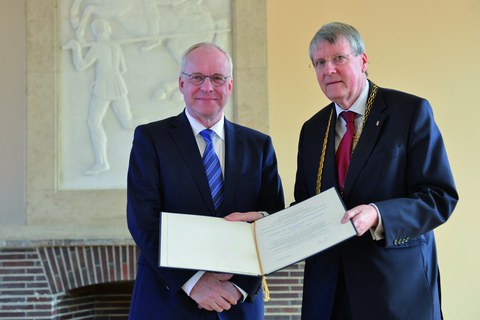
Prof. Manfred Curbach erhält seine Mitgliedsurkunde aus den Händen des Präsidenten der Nationalen Akademie der Wissenschaften Leopoldina, Professor Jörg Hacker (r.)
Im Rahmen des jährlichen Symposiums der Leopoldina-Klasse I haben hochrangige Wissenschaftler ihre Mitgliedsurkunden aus den Händen des Präsidenten der Nationalen Akademie der Wissenschaften Leopoldina, Professor Jörg Hacker, erhalten.
Unter den 15 Wissenschaftlern, die 2013 in die Klasse I hinzu gewählt worden sind, ist der einzige Dresdner Prof. Manfred Curbach vom Institut für Massivbau der Technischen Universität Dresden. Er ist in der Leopoldina – eine der ältesten Wissenschaftsakademien der Welt – Mitglied der Sektion Technikwissenschaften.
Die Leopoldina wurde 1652 gegründet und ist der freien Wissenschaft zum Wohle der Menschen und der Gestaltung der Zukunft verpflichtet. Mit ihren rund 1500 Mitgliedern versammelt die Leopoldina hervorragende Wissenschaftlerinnen und Wissenschaftler aus Deutschland, Österreich, der Schweiz und zahlreichen weiteren Ländern.
Gottfried-Brendel-Preis 2013
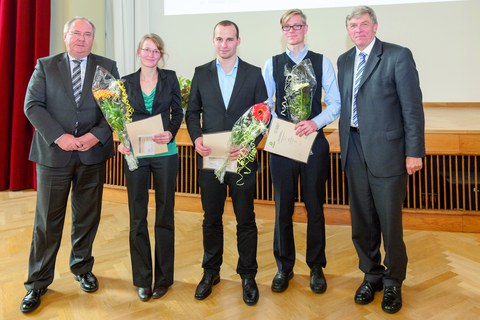
Preisverleihung beim Tag der Fakultät.
Den mit 3.000 Euro dotierten Gottfried-Brendel-Preis für besondere Leistungen im Rahmen der Projektarbeit im Fach Entwurf von Ingenieurbauwerken von Studierenden des 9. Semesters überreichte im Rahmen des „Tags der Fakultät“ für den Stifter Bilfinger SE Harald Möller (links im Bild). Preisträgerin 2013 ist Angela Schmidt für ihre Arbeit “Form Follows Force – Optimierung der Geometrie von Stützen”. Zwei 2. Preise wurden ebenfalls vergeben an Max Käding (“Entwurf einer Eisenbahnbrücke über die Röder”) und an Kevin Wahl (“Entwurf und Bemessung einer Radfahrer- und Fußgängerbrücke über die Ems nahe der Stadt Rheine”). Rechts im Bild der damalige Dekan der Fakultät Bauingenieurwesen, Prof. Rainer Schach.
Kurt-Beyer-Preis 2012
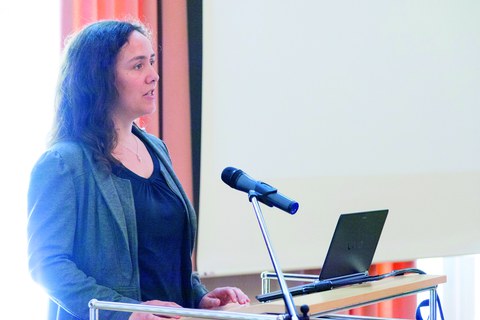
Dr.-Ing. Anett Brückner
Preisträger des seit 1996 jährlich verliehenen Kurt-Beyer-Preises 2012 sind Dr.-Ing. Anett Brückner, die ihre Dissertation zum Thema „Querkraftverstärkung von Bauteilen mit textilbewehrtem Beton“ am Institut für Massivbau der Fakultät Bauingenieurwesen schrieb, und Dipl.-Ing. Andreas Fuchs von der Fakultät Architektur. Seine Diplomarbeit setzte sich mit der “Erhaltung und Entwicklung von Seres Campill“ auseinander. Der Preis wurde im Juni 2013 im Festsaal des Rektorats verliehen.
Laudatoren der beiden Preisträger waren Prof. Manfred Curbach für die Fakultät Bauingenieurwesen und Prof. Gerald Staib für die Fakultät Architektur. Die Begrüßungsworte sprach die Prorektorin für Bildung und Internationales der TU Dresden, Prof. Ursula Schaefer.
Der Kurt-Beyer-Preis wird an der TU Dresden für herausragende Abschlussarbeiten an den Fakultäten Architektur und Bauingenieurwesen verliehen; er ist mit 5.000 Euro dotiert. Auslober ist seit 2011 die HOCHTIEF Solutions AG, für die Dipl.-Ing. Michael Pröbstl während der Veranstaltung sprach.

